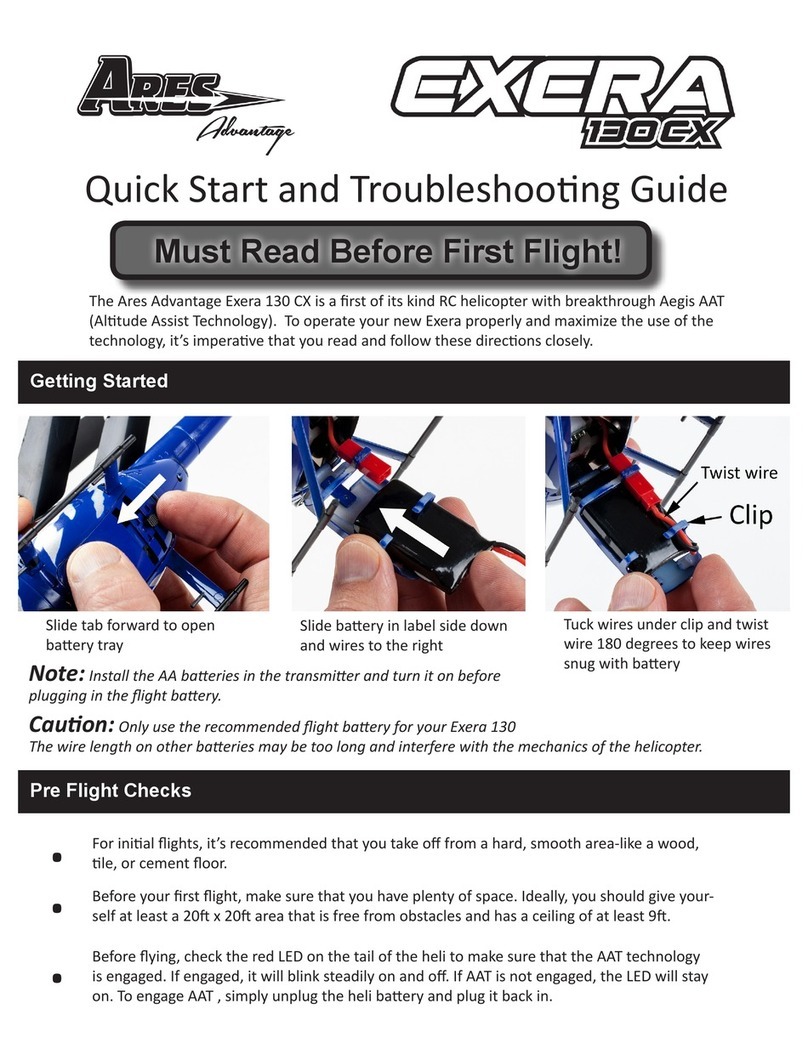
33
Safety Precautions and Warnings
As the user of this product you are solely and wholly responsible for operang it in a manner that does
not endanger yourself and others or result in damage to the product or the property of others.
This model is controlled by a radio signal that is subject to possible interference from a variety of
sources outside your control. This interference can cause momentary loss of control so it is advisable to
always keep a safe distance from objects and people in all direcons around your model as this will help
to avoid collisions and/or injury.
• Never operate your model if the voltage of the baeries in the
transmier is too low.
• Always operate your model in an open area away from obstacles,
people, vehicles, buildings, etc.
• Carefully follow the direcons and warnings for this and any op-
onal support equipment (chargers, rechargeable baeries, etc.).
• Keep all chemicals, small parts and all electronic components out
of the reach of children.
• Moisture causes damage to electronic components. Avoid water
exposure to all electronic components, parts, etc. not specically de-
signed and protected for use in water.
• Never lick or place any poron of the model in your mouth as it
could cause serious injury or even death.
The Ares Advantage Exera 130 CX is the most advanced and easiest to y 4-channel CX heli ever! Like
other CX helis on the market it features an ultra-stable coaxial, counter-rotang blade design that helps
make ying easy. However, what sets the Exera 130 CX apart is that it includes innovave Aegis Altude
Assist Technology (AAT).
Designed and developed exclusively by Aegis engineers, AAT automacally assists in maintaining
altude above the ground and avoiding collisions with the ceiling through the use of state-of-the-
art ultrasonic sensors similar to those found in the luxury automobiles for collision intervenon
and parking assistance. The resulng benet is that AAT makes it easy for rst-me pilots to master
4-channel control and gives low-me and experienced pilots added condence to y in smaller indoor
spaces where height is limited. Plus, with the Exera 130 CX, once 4-channel ight becomes easy, you
can turn o AAT completely and sll have a great looking, great ying heli!
The Ares Advantage Exera 130 CX arrives 100% factory-assembled, test own and ready to y. Standard
features include a unique and durable airframe design; a highly-detailed MD 500E scale body equipped
with LED lights; a 4-channel transmier with an LCD screen, dual rates and 2.4GHz technology; a
700mAh 1S 3.7V LiPo baery and an AC charger for convenient charging from almost any outlet. Best
of all, the AAT module and ultrasonic sensors are factory-installed and ready to use with no assembly,
setup or adjustments required!
So whether you’re a rst-me pilot looking for the best heli to start with or an experienced pilot
looking to expand your skills in ght indoor spaces, innovave Aegis AAT makes the Exera 130 CX
perfect for you!




























